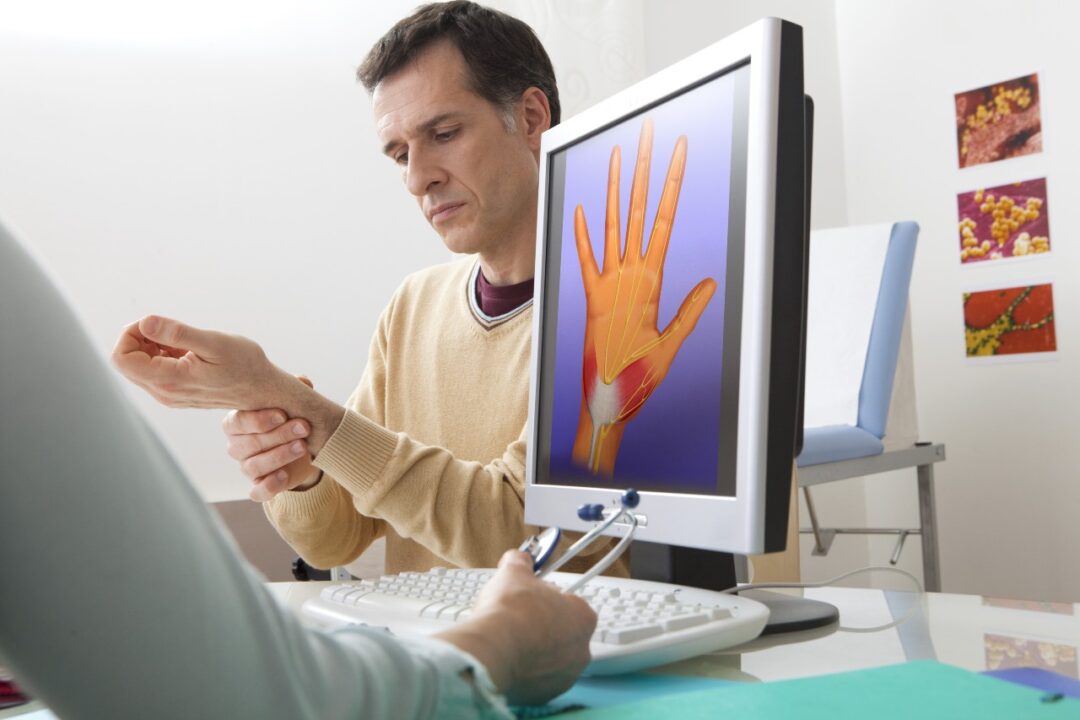What is the treatment for carpal tunnel syndrome? |

The carpal tunnel is a narrow passageway in the wrist that the median nerve passes through. The median nerve provides sensation to the palm side of the thumb, index and middle fingers. It also carries nerve impulses to the muscles of these digits to bring about movement. Carpal tunnel syndrome (CTS) occurs when the median nerve becomes compressed or ‘pinched’ in the carpal tunnel. Last week we looked at what caused CTS and how it is diagnosed. This week we’ll look at ways of treating CTS, and better yet, how it may be prevented.
How is carpal tunnel syndrome treated?
The decision of how best to treat CTS depends on a number of factors—-the severity of symptoms, the duration of the problem, and what’s causing CTS. Non-surgical as well as surgical treatments are available for treating CTS. In most cases, non-surgical options are employed initially, with surgery being reserved for severe cases or those that don’t respond to conservative measures. If CTS occurs in someone with medical problems such as diabetes or rheumatoid arthritis, the first step is make sure that the condition is being managed as well as possible. When CTS accompanies pregnancy, symptoms usually resolve after delivery.
What non-surgical treatments are available?
Of the non-surgical treatments, the ones most commonly employed are resting/splinting and use of corticosteroid medications. Initial treatment generally involves resting the affected hand and wrist for at least 2 weeks, avoiding activities that may worsen symptoms, and immobilizing the wrist in a splint to avoid further damage from twisting or bending. The best type of splint holds the wrist in a neutral (unbent) position. This serves to maximize the opening of the carpal tunnel, reducing pressure on the median nerve. Wearing the splint continuously, both day and night, for a period of time appears to be more effective than just wearing it at night.
If splinting and rest are not effective, use of a corticosteroid (e.g. prednisone), either taken by mouth or injected into the carpal tunnel is often the next step in treatment. Corticosteroids, are potent anti-inflammatory medications and help by shrinking inflamed tissue surrounding the carpal tunnel. Other non-surgical treatments include taking nonsteroidal anti-inflammatory drugs (NSAIDs), such as ibuprofen or naproxen and physical therapy measures such as ultrasound and mobilization exercises.
What if non-surgical treatments don’t help?
If several months of non-surgical treatment has been unsuccessful and the diagnosis has been confirmed, surgery becomes a reasonable option. A carpal tunnel release involves cutting a band of tissue (carpal ligament) at the wrist to reduce pressure on the median nerve. The traditional procedure requires an incision up to two inches in length on the wrist. A newer endoscopic method is done through one or two small incisions. Although complete recovery can take months, CTS symptoms rarely recur following surgery.
Can Carpal Tunnel Syndrome be prevented?
Although proof of measures to prevent CTS is lacking, the American Academy of Family Physicians has offered the following suggestions to help avoid developing CTS:
- Lose weight if you’re overweight
- Get treatment for any disease you have that may cause carpal tunnel syndrome.
- If you do the same tasks with your hands over and over, try not to bend, extend or twist your hands for long periods.
- Don’t work with your arms too close or too far from your body.
- Don’t rest your wrists on hard surfaces for long periods.
- Switch hands during work tasks.
- Make sure your tools aren’t too big for your hands.
- Take regular breaks from repeated hand movements to give your hands and wrists time to rest.
- Don’t sit or stand in the same position all day.
- If you use a keyboard a lot, adjust the height of your chair so that your forearms are level with your keyboard and you don’t have to flex your wrists to type.
If you have any more questions just Ask Hanna, our health advisors are here to help.
Image: ©Shutterstock / Image Point Fr








